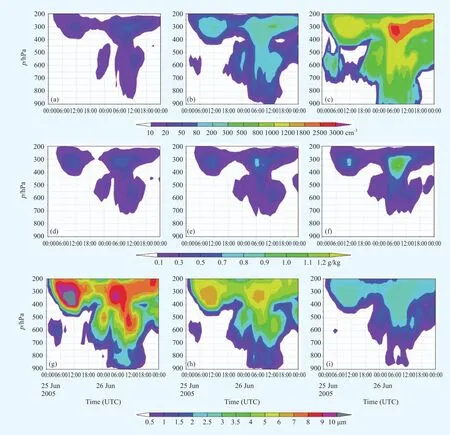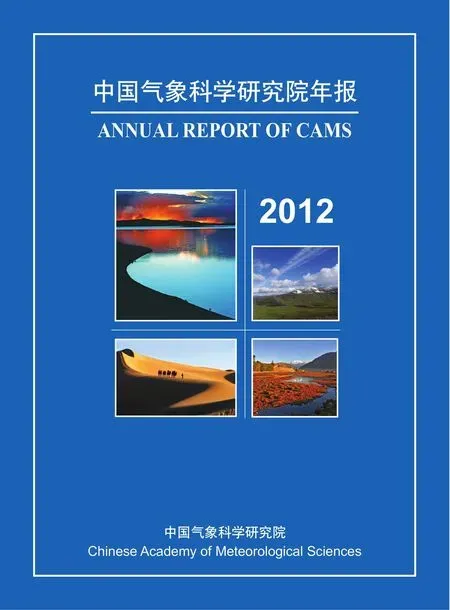云降水物理与人工影响天气研究进展
大气物理与人工影响天气
Atmospheric Physics and Weather Modifcation
云降水物理与人工影响天气研究进展
1 云雾物理观测与数值模拟研究
1.1 环北京春季大气气溶胶分布、来源及其与CCN转化关系的飞机探测
利用2009 年春季开展的“环北京云观测试验”观测的气溶胶和云凝结核(CCN)数据,研究了试验期间大气气溶胶的分布、来源特征及其与CCN的转化关系。结果表明,高浓度气溶胶基本分布在4500 m以下的区域,量级可以达到103cm-3。4500 m以上气溶胶呈显著下降趋势,量级仅为10 cm-3;气溶胶平均直径在0.16~0.19 μm之间。4500 m以下气溶胶平均粒子谱呈双(多)峰分布,而在4500 m以上基本为单峰分布。受气溶胶来源特性差异的影响,在0.3%的过饱和度下,4500 m以下气溶胶转化为CCN比例不到20%,但在4500 m以上可高达近50%。气团移动轨迹显示,4500 m以上的大气高层均受到来自沙尘等较大尺度粒子的影响,飞机观测的高CCN 浓度说明这种较大尺度气溶胶粒子可溶性较大。而4500 m以下的低层,由于受到局地或区域地面污染的影响,气溶胶的尺度较小,核化为CCN的过饱和度要求较高,因此气溶胶到CCN 的转化率低。同时建立了气溶胶浓度和CCN 浓度的拟合关系。(卢广献)
1.2 人为污染物对冬季雾形成和发展的影响研究
基于WRF/Chem模式和雾的观测资料,开展了包含和不包含人为污染排放源两种大气背景条件下的数值模拟对比试验,在此基础上探讨了人为污染物对2009年12月1日发生在我国华北和华东地区的一次浓雾天气过程的影响机理。结果表明,在考虑污染排放源时,模式模拟的雾的空间分布和强度变化与卫星、能见度仪和微波辐射计的观测更为接近。污染条件下的边界层结构更有利于雾的形成,人为大气污染物使雾的范围最大增加50%,雾的强度最大增加5倍,雾持续时间平均延长1.5 h。由于人为污染物增加了雾凝结核(FCN)数浓度,进而使雾滴数浓度显著增大,有利于雾的增强。同时,污染物通过影响雾滴的凝结过程和潜热释放过程,对长波辐射降温和湍流过程有重要影响,使边界层的热力和动力结构更有利于雾的增强和发展。污染气体SO2、NOx和NH3排放产生的二次气溶胶对雾的形成和发展具有重要影响。不考虑这些污染气体排放时,平均雾水含量可降低32%。(郭学良)
1.3 飑线灾害性大风产生的微物理机理研究
采用卫星、雷达及地面加密观测资料,结合中尺度WRF数值模式,研究了河南2009年6月3日飑线产生的天气背景、宏微观结构特征及造成灾害性大风的机理。结果表明,此次飑线过程的主要影响系统是东北冷涡,其后部横槽引导的南下冷空气与西南暖湿气流在河南新乡南部一带交汇促发强对流过程,最后演变为飑线。但由于低层西南风偏弱,水汽条件不足,飑线发生的环境较为干冷。飑线产生区大气处于条件性不稳定状态,对流有效位能(CAPE)在1300 J/kg左右,并具有适当的垂直风切变。地面气象场显示飑线具有相对冷湿的雷暴高压和强冷池,飑线过程产生的灾害性天气以大风而非强降水为主。数值模式结果显示,飑线下沉气流的最大值仅为13 m/s,而地面风速最大值达到35 m/s,是最大下沉气流的2.7倍。进一步的数值敏感试验表明,降水粒子的蒸发和融化冷却过程对降低地面温度和产生地面强风具有重要影响,其中雨水蒸发过程产生的最大等效冷却率为3 K/min,远大于霰融化冷却率0.7 K/min,因此雨水蒸发过程是影响冷池强度的关键因素,而地面强冷池在此次飑线灾害性大风的产生中具有重要作用。(郭学良)
1.4 北京周边细粒子气溶胶及云凝结核谱特征分析
利用TSI3936扫描电迁移率粒径分布谱仪观测的细粒子气溶胶与云凝结核(CCN)计数器进行对比,结合周边地区大气颗粒物数谱分布的主要特征和类型,分析了2011年11月10—15日河北涿州细粒子气溶胶对CCN形成的影响。结果表明,细粒子气溶胶峰值集中在100 nm周围,午后谱宽最窄且数浓度最低,主要的气溶胶来源大部分为交通污染的一次排放;气溶胶细粒子数浓度较高时,观测的CCN数量在各饱和度条件下一般较高,过饱和度0.6%时,CCN值最高;随着过饱和度的增加,CCN的谱宽明显渐宽。11日为雾日及12日晴空无云,细粒子气溶胶数浓度对应明显变小,CCN值也对应减小; 10日虽然气溶胶细粒子较少,但是不同过饱和度观测到的CCN值并不很低,这可能是较大粒子活化产生的CCN;由于细粒子主要成分吸湿性不佳,不利于活化,12日凌晨细粒子较多,但活化CCN较小且峰值向较小半径倾斜(图1)。(段婧)
2 人工影响天气研究
2.1 利用AgI催化剂进行华南暴雨人工减雨的数值试验
在对流云模式中增加了AgI两个预报量,耦合了考虑受水汽过饱和度和温度影响的4种核化机制的AgI催化模块,使其具备了AgI 类催化剂的模拟能力,能够研究AgI 类催化剂对对流云系统的影响。利用此模式对一次华南暴雨过程进行了人工缓减暴雨的成冰剂催化数值模拟试验。模式采用AgI催化方法,对人工缓减暴雨的可能性及原理进行了研究。模拟结果表明,在适当的时机对适当的部位进行大剂量的催化,可以减少总降水量,也可以减小最大降水中心的雨强。当催化剂量达到2×108(个/kg)时,可以减少39.3%的降水量,具备有效减缓暴雨成灾的可能性。大剂量催化后,大量的AgI粒子在冷区核化,消耗了大量的过冷水。霰粒子的落速和雨水的落速减小,导致了降水量的减少。AgI在对流云中主要以受过饱和度影响的凝结冻结和催化剂长时间作用的浸没冻结这两种方式成冰。本研究所用催化方法在实际作业中具有技术可行性,并有较大社会和经济效益,值得深入研究和试验。(楼小凤)
2.2 北京地区人工减雨的数值研究
利用耦合了中国气象科学研究院复杂双参数云物理方案的GRAPES中尺度数值模式,对2008年夏季北京地区的降水过程进行了人工减雨的冷云催化数值试验,研究了减雨的作业条件、作业效果和机制。结果表明,采用过量播撒冷云催化方法可以引起地面减雨,催化区适宜设在目标区上风方过冷水含量丰富的地区;过量播撒时剂量越大减雨效果越好,并且连续播撒好于单次播撒;催化引起地面雨量再分布,减雨区周围伴有增雨区,但区域雨量总体变化为减雨。过量播撒引起微物理量含量和转化过程强度发生变化,霰的融化、雪的融化和雨滴碰并云滴增长过程受到削弱,使雨水含量减少。同时也发现,催化也引起动力和热力场发生变化,并可能会通过平流扩散等过程产生上下游效应,使催化效应延长。(孙晶)
2.3 巨核对暖云降水的影响
利用耦合了新的暖云参数化方案的中尺度模式MM5,研究了暖云降水中巨核(GCCN)的作用。在该暖云方案里,先假定一个3模态的气溶胶正态对数分布,然后考虑对流、扩散、云滴和雨滴的核化非核化过程,再由气溶胶质量的预报量显式地计算出气溶胶的数浓度。以华北地区2006年6月25—26日的一次弱冷锋过程为例,研究了巨核对云和降水的影响。研究表明,巨核具有增强雨滴的凝结、碰并和云雨自动转化过程的作用,使云滴数减少高达40%,云水减少20%,云滴有效半径增加高达30%左右。在污染和清洁环境下巨核均可增加降水(图2)。(房文,郑国光)

图1 2011年11月10—15日河北涿州细粒子气溶胶和不同过饱和度条件下CCN的小时平均谱的时间变化Fig1 Spectra distribution of fne particle aerosol and CCN under different supersaturation conditions during 10—15 November 2011 over Zhuozhou, Hebei Province, China

图2 清洁大陆(a~c)、平均大陆(d~f)和北京城市气溶胶分布(g~i)下模拟的云滴性质:云滴数浓度(a、d、g),混合比(b、e、h),有效半径(c、f、i)Fig2 Cloud-drop properties under clean continental (a-c), average continental (d-f), and urban (g-i) aerosol conditions. Averaged cloud-drop number concentrations (a, d, g), mass mixing ratio (b, e, h), and effective radius (c, f, i)
Progress in Studies on Clouds and Precipitation and Weather Modifcation
1 Observational and numerical modeling studies of cloud/fog physics
1.1 Distribution and origin of aerosol and its relationship with CCN based on springtime multi-aircraft measurements of the Beijing Cloud Experiment (BCE)
The atmospheric aerosol distribution, source, and its relationship with cloud condensation nuclei (CCN) observed during the Beijing Cloud Experiment (BCE) are analyzed. The results show that the high number concentration of aerosol was mainly distributed below 4500 m, with the magnitude reaching 103cm-3. Above 4500 m, the aerosol number concentration decreases to 10 cm-3with the increasing altitude, and the aerosol mean diameters were between 0.16 and 0.19 μm. Below 4500 m, the number size distributions of aerosol showed a bimodal (multimodal) mode, and a unimodal mode above it. Due to the different sources of aerosol, the conversion ratios of aerosol to CCN were less than 20% below 4500 m, and reached 50% above the level at 0.3% supersaturation. The back trajectories showed that aerosols at higher levels above 4500 m were strongly affected by large-size particles and those below 4500 m were strongly affected by local or regional pollution. Based on observations, a relationship between the CCN number concentration and aerosol number concentration is established. (Lu Guangxian)
1.2 Impacts of anthropogenic atmospheric pollutant on formation and development of a winter heavy fog event
The WRF/Chem model coupled with local anthropogenic atmospheric pollution emissions and fog observational data were used to assess the effects of human-induced pollutants on a heavy fog event on 1 December 2009 in North China and East China. The experiments with and without anthropogenic emissions were designed and conducted. The results suggest that the simulated fog distribution and intensity with anthropogenic emission are closer to observed ones. The polluted atmospheric boundary layer condition is found to create a favorable condition for fog formation, increasing the fog area by 150%, the intensity of 5 times in maximum, and the duration of additional 1.5 h on average. Compared with that under the clean air condition, the number concentration of fog condensation nuclei (FCN) is much higher in polluted air, which causes a higher fog droplet number concentration, and infuences the processes of droplet condensation, long wave radiation, turbulent motion, and provides the favorable dynamic and thermal boundary conditions for fog development. The secondary aerosols produced by trace gases SO2, NOx, and NH3exert great infuences on the formation and development of fog, and the averaged liquid water content decreases by 32%, without these trace gas emission. (Guo Xueliang)
1.3 Numerical simulation studies on severe surface wind formation mechanism and structural characteristics of a squall line
An unusually severe squall line resulted in significant losses of lives and property on 3 June 2009 in Henan Province, China. To better understand the genesis and development mechanisms of the squall line, the data of satellite, radar, intensive surface observation, and the mesoscale Weather Research and Forecasting (WRF) model were used to investigate the atmospheric background, macrostructure, and microstructure of the squall line and the formation mechanism of the damaging surface wind. The results show that a northeast cold vortex was the main infuencing system of the squall line. The transversal trough located at the back of the northeast cold vortex induced a strong cold airfow, which met a relatively weak southwesterly warm and moist airfow to produce convection. The system further developed in the study region as a severe squall line.The atmosphere contained weak southwesterly winds and water vapor in low layers; thus, the atmospheric environment of the squall line formation was dry. The atmosphere was conditionally unstable with a convective available potential energy (CAPE) index of approximately 1300 J/kg and adequate wind shear. A relatively cold and moist high with thunderstorms and a strong cold pool on the surface field occurred concurrently with the squall line to produce severe surface wind in addition to heavy rain. The results of the WRF model showed that although the maximum downdraft of the squall line was only 13 m/s, the surface outfow wind speed was 35 m/s, which exceeded the maximum downdraft by a factor of 2.7. Further investigation revealed that the cooling processes of rain evaporation and graupel melting were the major contributors to the decrease in surface temperature and strong wind production. Among them, the cooling rate due to rain evaporation was approximately 3 K/min while that due to graupel melting was approximately 0.7 K/min. Therefore, the key factor to infuence the cold pool intensity was rain evaporation; this cold pool played a critical role in the formation of the severe surface winds during the squall line event. (Guo Xueliang)
1.4 Characteristic of spectra of fne particle aerosol and CCN around Beijing, China
The aerosol (from TSI3936) and CCN (from CCN contour) data observed in winter of 2011 over a satellite city of Beijing are used to analyze the distribution of fine particle aerosol and CCN in different weather conditions and their diurnal variation characteristics. In consideration of the characteristics of fine aerosol spectra in the nearby region, the aerosol infuences on CCN formation are investigated preliminarily. The results show that∶ (1) The peak value of fne particle aerosol is concentrated around 100 nm. The aerosol spectra are the narrowest and the aerosol number concentration is the lowest in the afternoon. The pollution emission from automobiles is the main aerosol source. (2) Around 04∶00, there is a lower concentration of aerosol but higher CCN at different supersaturation (SS) conditions. (3) The highest value of CCN appears at 0.6% SS. The spectra are obviously wider with increasing SS. Although the fne particle aerosol concentration is low on 10 November 2011, the CCN concentration is not accordingly low. This may arise from activation of big particles. When more fne particles exist on 12 November, the CCN concentration is low, and the peak value of CCN concentration is low as well (Fig1). (Duan Jing)
2 Weather modifcation studies
2.1 Simulation study on the effect of AgI seeding on heavy rainfall reduction in South China
An AgI seeding scheme is coupled with a three-dimensional cloud model, considering four nucleation modes. A case of heavy rainfall during the South China heavy storm in 1998 is simulated using this model. Numerical seeding experiments of releasing AgI in clouds are conducted to study the possibility of heavy rainfall attenuation through the AgI seeding. Several tests for different locations and with different concentrations of seeding particles are designed. The results show that overseeding in the updraft area with supercooled water can not only reduce the amount of rainfall, but also reduce the maximum rainfall strength. With 2 × 108kg-1seeding concentration, rainfall amount can be decreased by up to 39%, which greatly lowers the possibility of fooding. After seeding with large amounts of AgI, numerous AgI particles are nucleated, and these ice particles consume most supercooled water. The falling speeds of graupel become so smaller (some even weaker than the updraft) that many graupel particles can not fall down to the warm region to melt into raindrops. The bigger number of graupel particles contributes the bigger number of rain droplets with weaker falling speed. The time of peak rainfall is delayed and the duration of peak rainfall is shortened, thus the surface rainfall is decreased. The results also show that condensation freezing and immersion freezing are the dominant nucleation modes in convective clouds. The over-seeding methods used in this investigation are feasible and applicable in practical feld experiments. (Lou Xiaofeng)
2.2 Numerical study on artifcial seeding for rainfall reduction in Beijing
A heavy rainfall episode happened on 14 July 2008 in Beijing. This event is simulated by using the mesoscale model GRAPES coupled with the CAMS (Chinese Academy of Meteorological Sciences) cloud microphysical scheme. Numerical experiments on the effects of adding ice crystals are conducted to study if there is any possibility to decrease the heavy rainfall. Several tests for different seeding times and different concentrations of seeding particles are designed. The results show that overseeding ice particles in cold clouds results in the reduction of rainfall. The seeding area should be selected in the upwind side with lots of supercooled water. The seeding effect is better when the amount of seeding ice particles is higher. Seeding results in the redistribution of rainfall. Several areas with increased rainfall also appeared. After overseeding ice particles, the processes of the graupel and snow melting and the cloud water collection by rain water are weakened. These result in the decreasing of rainfall. The dynamical and thermodynamical processes are altered by the overseeding. The advection and diffusion processes may expand the affecting area. (Sun Jing)
2.3 The effect of GCCN on warm-cloud precipitation
A warm cloud microphysical parameterization was incorporated into a regional model to study the sensitivity of cloud-radiative properties and precipitation to giant cloud condensation nuclei (GCCN) concentration changes. By assuming a tri-modal lognormal aerosol size distribution, the aerosol numbers are explicitly calculated from prognostic aerosol masses, with considerations of advection, diffusion, and cloud and rain drop activation/deactivation processes. Sensitivity experiments of a cold front passing through northern China during 25—27 June 2005 with different initial conditions for clean, continental, and urban types of aerosols were then conducted to study the GCCN effects. It is found that the presence of giant nuclei enhances the condensation, collection, and cloud-rain auto-conversion process, leading to the decreases of cloud drop numbers and cloud water by up to 40% and 20%, respectively, and the increase of cloud drop radius by 30%. The GCCN increases accumulated precipitation in both polluted and clean environments (Fig2). (Fang Wen, Zheng Guoguang)

